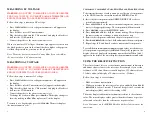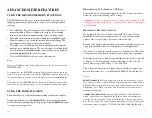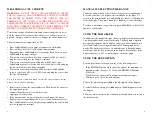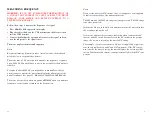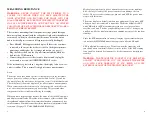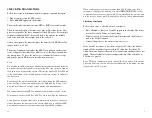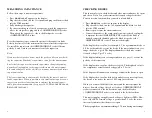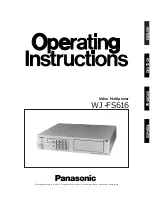
14
ADVANCED METER FEATURES
USING THE MIN/MAX MEMORY FUNCTIONS
The MIN/MAX feature lets you track the high and low values for a
changing measurement. Follow these steps to store the high and low
readings.
• Press
MIN
/
MAX
. The meter displays [
MIN
] and displays the lowest
measured reading. The meter updates the display as the reading
changes. Both minimum and maximum values are being stored.
• To display the maximum measured reading, press
MIN
/
MAX
again.
The meter displays [
MAX
] and the highest measured reading. The
meter updates the display as the readings change.
• To display the actual reading, and record maximum and minimum
readings, press
MIN
/
MAX
again. The meter displays [
MIN
] and [
MAX
].
• To clear the minimum and maximum measurements, press and hold
down
HOLD
/
RELATIVE
for about 2 seconds.
• To exit the MIN/MAX mode, press any other function.
Notes:
If you press
BEEP
to turn the beep feature on or off, the meter exits the
MIN/MAX mode.
You cannot use the MIN/MAX mode and the relative mode at the same
time. If you select the relative mode, the MIN/MAX function turns off. If
the relative mode is already active, the meter ignores the
MIN
/
MAX
key.
The meter exits the MIN/MAX mode if you try to measure a value that
is outside the currently set range or if you manually change the range.
USING THE HOLD FUNCTION
The hold feature lets you hold the current reading on the meter’s display.
During any reading, press
HOLD
/
RELATIVE
to prevent changes in any
measured value from updating the display. Press
HOLD
/
RELATIVE
again
to resume normal operation.
3
M
EASURING
AN
AC V
OLTAGE
ON
A
DC B
IAS
To measure an AC voltage superimposed on a DC voltage source bias,
follow the steps for measuring an AC voltage.
Caution:
Never try to measure an AC voltage that is riding on a DC
voltage level where the peak AC voltage exceeds 1000 V with respect
to earth ground.
M
EASURING
3-P
HASE
AC V
OLTAGES
We designed this meter to measure household AC voltage. It is not
intended for commercial or industrial use. If you want to measure
3-phase, line-to-line voltages, please note the following:
Because of the dangers inherent when you measure three-phase circuits, we
strongly recommend you do not use this meter for such applications.
If you choose to make the measurements, use extreme care. The actual
voltage can be greater than the circuits rated voltage (line-to-ground).
To determine the line-to-line voltage, multiply the rated line-to-ground
voltage by 1.732. For example, if the rated voltage is 462 volts, the
line-to line voltage is 462 Volts x 1.732 = 800 Volts.
This voltage exceeds the meter's range and you should not connect the
meter to this circuit. (
See cover,
M
EASURING
H
IGH
-V
OLTAGE
C
IRCUITS
.)
Notes:
PHANTOM
READING
:
If you do not connect the meter's probes to a cir-
cuit, and set it to
DC
or
AC
VOLTS
, the display might show a
PHANTOM
READING
.
This is normal. The meter's high input sensitivity produces a
wandering effect. When you connect the test probes to a circuit, a real
measurement appears.
OVERRANGE
INDICATION
:
A single large number 3, fully-filled bar
graph, and right arrow appear on the display when a measurement
exceeds the meter's range. If you are measuring volts or amps, discon-
nect the meter from the circuit you are measuring or change the meter's
measuring range. (See page 13,
M
ANUALLY
S
ELECTING
THE
R
ANGE
.
)


